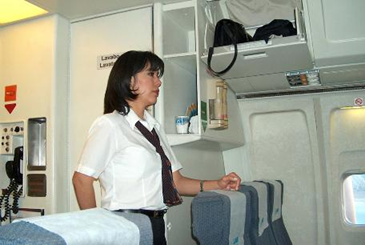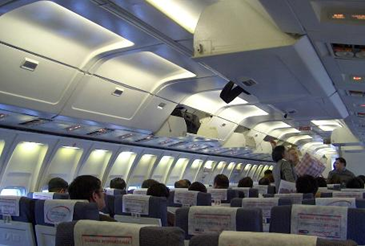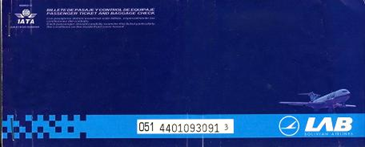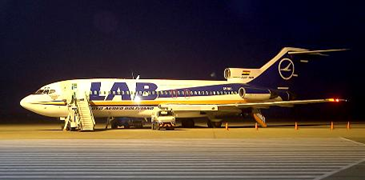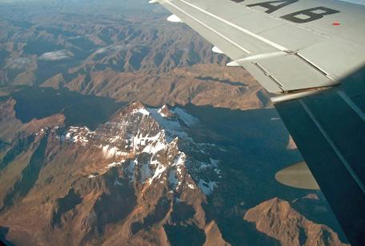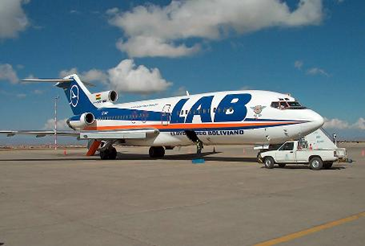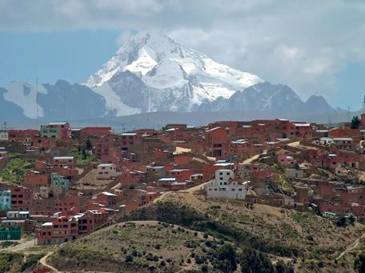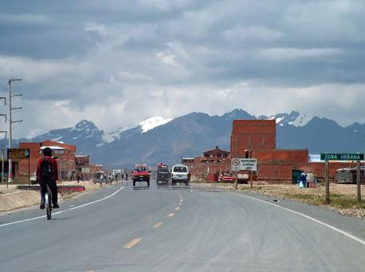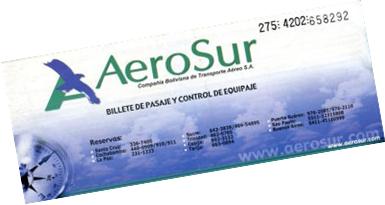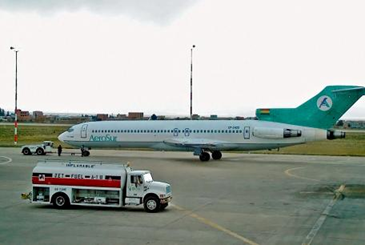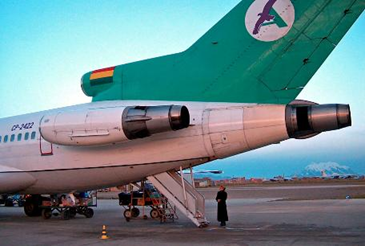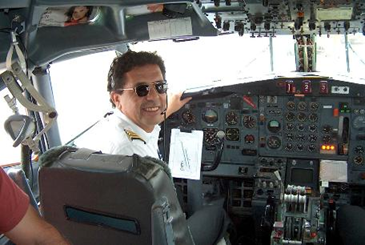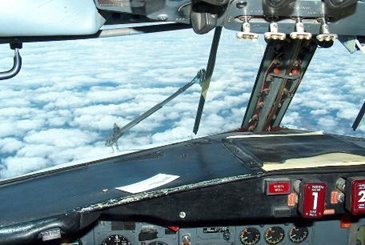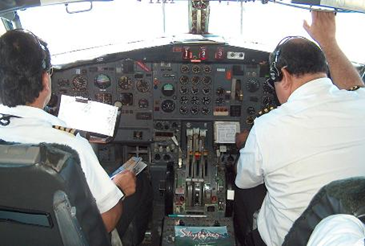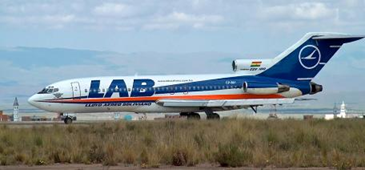Above the Bolivian Andes in a Boeing 727
By Micheal Prophet
|
In 2005 one of my long, overdue, wishes became a reality. I always wanted to visit Bolivia to photograph the Bolivian meat-haulers out of La Paz airport, but somehow it never happened. Early March I found myself and two spirited aviation friends on my way to South America with final destination Cochabamba. We had previously booked our flights in Holland with LAB (Lloyd Aereo Boliviano) and our connecting airport was going to be Sao Paulo. We crossed the Atlantic Ocean onboard a British Airways B747-400 departing from London Heathrow airport. After a gruelling 12 hours flight we landed in the early morning hours at Sao Paulo Guarulhos international Airport. Our onwards connecting flight was late in the afternoon 17.25 hours local, so we killed time, wandering around the airport terminals, trying various snackbars and checking out the observation lounge.
By mid afternoon we decided to join the long check-in queue at the LAB counter. Never in my life had I stood in such a long line! We finally made it to the gate and boarded our flight LB942, which turned out to be the CP-2324 a Boeing B727-2M7 (c/n 21823). We received seats in the business class section of this aircraft and enjoyed some friendly service & cool drinks. Our flight to Santa Cruz Viru-Viru airport took 2 hours and 30 minutes and was a smooth ride. At Santa Cruz our connecting flight was already awaiting us, and this time we boarding LB848. This flight was operated by CP-2464 another Boeing trijet B727-223 (c/n 22464) and it took us to Cochabamba in 40-45 minutes. I remember this flight well; it was already dark as we approached Cochabamba. I remember seeing city lights at wing level as we were descending! It made me a little nervous as the city of Cochabamba is surrounded by high mountains. We landed with a hard bump and the engine’s thrust reversers immediately kicked in. The flight attendant smiled and greeted us a warm welcome in Cochabamba. Cochabamba I later learned that this sort of high-speed approach and landing is very much the norm for this airport. We exited the 727 via the aft air-stair and walked towards the terminal. I noticed numerous military guards on the ramp, also normal in Bolivia. Luckily all our bags made it to Cochabamba as well, and within minutes we were on our way to our hotel, the Gran Hotel ambassador in the heart of the city. A couple of days later we received an invitation to visit the LAB maintenance centre, which is next to the main terminal. Our friends from Lineas Aereas Canedo (LAC) made the contact. We were greeted by Mr. Antonio Vargas Alcocer (LAB - Jefe Depto Garantia de Calida) who escorted us around the facility. Inside the main hanger a 727 was in a heavy C-check while outside a LAB B767-300ER was receiving some minor attention. Around the corner we entered a withdrawn B727-100 series and walked through its cabin and cockpit. This aircraft had finished its flying career and was now used as an instructional airframe. Unrest When we arrived in Bolivia, we heard from the local TV that the Bolivian president, Carlos Mesa, had just resigned from office. In a western country this is just political news, but in Bolivia this usually means civil unrest! We didn’t notice disturbances in Cochabamba and left the issue alone. With some time to spare we decided to visit La Paz airport, the highest international airport in the world with its elevation at 4.057 meters (13.310ft). Simultaneously this gave us another opportunity to fly on a LAB Boeing 727. At LAB ticket office we checked the schedules and found out that the morning flight was served by LAB oldest B727: the CP-861 (B727-1A0 c/n 20279). For just 50 dollars we booked ourselves a one-way ticket on flight LB810. CP-861 So on the 8th of March 2005 we boarded CP-861 for an early morning departure. Outside it was still cold and misty; we seated ourselves at the back of the 727 Spartan cabin. This way we could enjoy the sound of the original Pratt & Whitney JT8D-7 turbofans engines. We taxied off the ramp and back-tracked for our take off position from runway 32. At 10 minutes past 07.00 hours we started our take-off run. It’s seemed to take forever but we soon rotated and made a steady climbing turn away from some hills. Looking out my window, all I could see was barren mountains coming closer and closer. We soon got into our cruise mode and I sat back and enjoyed the scenery below. As we arrived into the La Paz area I noticed the snow capped Mount Ilimani; which has an elevation of 6438 meters. We started descending over the city of El Alto on a downwind track. Then we made a left hand turn for base and final approach. I noticed that the engines noise was becoming louder and louder. On our final approach for runway 10 it almost felt that the engines where running at full power. We landed smoothly but couldn’t help notice the many bumps on the runway. It was really shaking up the old 727 jet! I guess we made it into La Paz J.F. Kennedy International Airport safely, and the airplane was still intact. Lake Titikaka Our original plan was to stay for a couple of days and visit Lake Titikaka and the Tihuanacu Ruins. After meeting our LAB contact, who arranged our taxi; we enjoyed an excellent airport tour by Mr. Antonio Lara Reuvella (LAB – Jefe Div Mantenimiento), who took us to see the old DC-6s and C46s on deserted gravel ramps of El Alto. At noon we sampled some typical Bolivian lunch at the airport cafeteria and got into our taxi for a trilling ride to down town La Paz. Due to the civil unrest there where many roadblocks out of La Paz and we could not visit Lake Titikaka and we ended up driving back to El Alto. El Alto is a busy place and a somewhat dangerous for European tourist. We instructed our taxi driver to turn around and head back to the airport. Clearly we were not here at a good time. Back in the terminal we decided to fly back to Cochabamba where the atmosphere was much nicer and friendlier. We checked with Aerosur and sure enough they had seats available for the late afternoon flight 5L-119 leaving at 18.25 (local). Back to Cochabamba We spend our last hours of the afternoon at the little cafeteria above the check-in counters. It had plenty of dirty windows over looking the main ramp. A half hour before our departure Aerosur 727-200 CP-2422 arrived, signaling us to head out for the gate. As always we entered the CP-2422 via the aft air-stairs and had my last look across the ramps to El Alto. It was already getting dark as we took off for Cochabamba. I settled back in my seat thinking what a hectic day it was at La Paz. Our last two days where spend in Santa Cruz. We explored the city and visited the downtown airport, where we saw one of the last operational C-46s in Bolivia. Additionally we visited the old Lockheed L749 Constellation, painted in Aerosur colors, and standing in a small park near a busy road. Santa Cruz has a very different vibe compared to the rest of Bolivia. The climate was more tropical and the people have lighter skin color, you could sense that you where closer to the Brazil. On the 16th March we checked in at Viru-Viru airport which is about a 30 minutes drive out of the city for our flight to Sao Paulo. The small terminal is very modern and taking pictures is forbidden. While waiting for our flight Aerosur 727-200, CP-2422 turned up at the gate on time. We departed at 09.40 local time; for a 2 hour and 20 minutes flight. Via our friends at LAC we got the name of the captain and introduced ourselves as two crazy Dutch photographers. The friendly crew under the command of Captain Eduardo Beltran invited us into the cockpit and allowed us to stay for the landing at San Paulo. We arrived on time but our British Airways flight was delayed for 12 hours! Postscript: CP-861 first flew from Renton in 12-08-69 and was delivered to Lloyd Aereo Boliviano in 12-02-70 and it operated continuously to LAB until around March-2007. It is now Stored at CCB with total hours 66900 and total cycles 79800. (It is reportedly the World's high cycled B727) It Never suffered any major incidents. No other Boeing jet aircraft has flown so long for the same carrier as CP-861. Right up until retirement in Mar07, aircraft was notching-up up to 16 cycles a day flying 90% of LAB Bolivian domestic routes. Engines never hush-kitted so as not to sacrifice power or reverse thrust on the 3 engines (With thanks to Máximo Gainza, Alexandre Aero-Transport-Data Bank & Marcelo Magalhães) Header photo by: Eric Alexandre |
|
